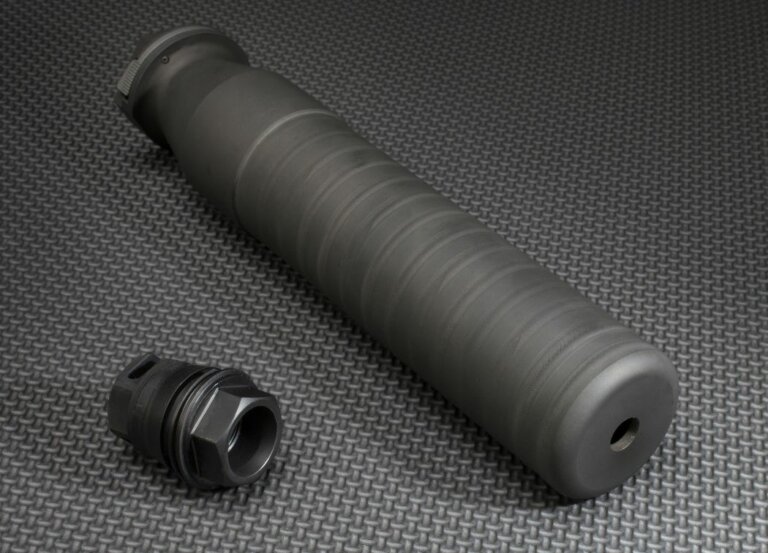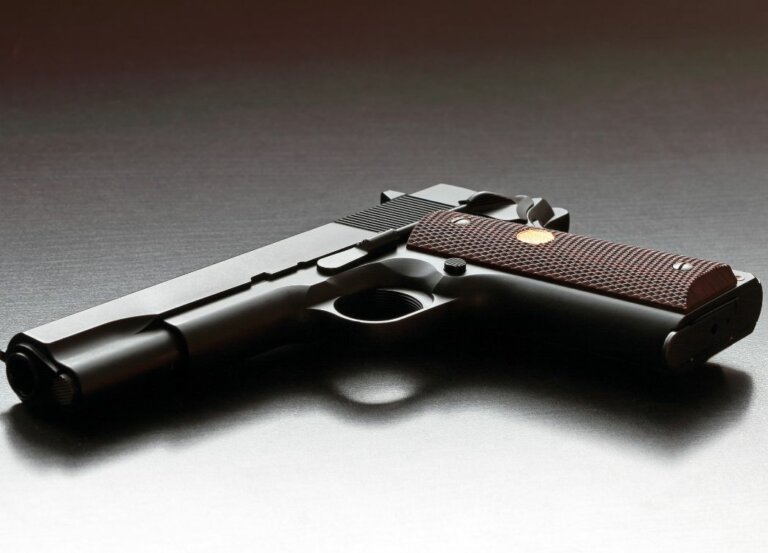Silencer Cover – Do You Need It?
If you use a magnifier for precision when shooting, you would have probably noticed that your gun gets hot after firing a few rounds.
Moreover, with the mirage effect, your visibility and clarity also take a toll and can be a huge distraction. Similarly, if you shoot using a suppressed rifle for more extended periods, it can get unusually hot.
One of the best solutions for these problems would be to use a silencer cover.
But what are silencer covers, and where are they used?

What is a Silencer Cover?
Silencer covers are more than just a piece of cloth that you wrap around your rifle silencers.
Besides eliminating the optical mirage effect that can distort your aim, they also allow you to handle the weapon safely by not letting you come in direct contact with it.
Another purpose that silencer covers serve is to reduce the noise produced by the gun. Though the silencers themselves do a great job here, silencer covers can be a great add-on to have that help further reduce the noise.
However, even with the silencer and a cover, the sound produced isn’t eliminated.
Silencers tend to heat up, especially after many rounds of rapid firing. At one point, they become dangerously hot to handle. Exactly how hot suppressors can get depends on the type of firearm used.
For instance, when fitted in an AR-15 rifle, silencers heat up after just 30 rounds of rapid firing. Likewise, all semiautomatic and automatic rifles also get hot quickly after a few rapid-fire rounds.
While all this may be common sense, you need to understand the amount of heat they produce. When fitted with silencers, these firearms can reach up to 500 degrees Fahrenheit in just a few minutes.
As scary as this may sound, what is even more alarming is that the temperatures can soar to 800 degrees Fahrenheit after firing two 30 round clips of 0.223 or 5.56. So, it is recommended that you don’t touch the suppressor even after firing one round, as it may have gotten too hot already.
Some firearm suppressors or silencers start emitting smoke as they heat up, which isn’t necessarily a bad thing since you take that as a warning and refrain from touching the silencer or the firearm.
Where are Silencer Covers Used?

Most silencer covers have an inner core and an outer cover or jacket.
The inner core comprises a fireproof material such as Kevlar or Nomex to contain the heat generated by the firearm suppressor. The outer jacket is usually synthetic fabric that latches the core onto the silencer.
It offers camouflage to the firearm and protects it from excessive heating in many cases. While some modern silencer covers don’t consist of a core, this is the standard configuration in most cases.
Different silencer covers find uses in different firearms such as rifles and pistols. For instance, the Burn-Proof Gear Suppressor Cover comprises the standard jacket-core setup. The cover comes in three different configurations, each of which finds uses in rifles (Heavy), pistols (Medium), and rimfires (Lite).
Similarly, Magpul’s silencer covers comprise a heat-resistant sleeve and raised heat shield made of stainless steel capable of keeping the exterior temperatures up to 1000 degrees Fahrenheit cooler than the surface of the silencer. So, there are different suppressor covers for different firearms, and no one silencer cover fits all firearm types.
However, when buying a cover for your firearm silencer, you must consider a few things. One such crucial aspect is the heat rating. Some of the best suppressor covers have ratings as high as 3000 degrees Fahrenheit and may be suitable for any use case.
Since suppressor covers rely on their core bulk to prevent the firearm silencer from heating, the higher the rating, the larger the cover, and the more weight you need to carry.
For this reason, those firing at moderate ranges should refrain from using heavier suppressor covers. However, if you are used to carrying the extra weight, you may as well go for a higher-rated silencer cover.
Benefits of Silencer Covers
Silencer covers offer lots of benefits. In addition to keeping the heat generated by the silencer from escaping into the other parts of the firearm, they also provide a host of other benefits, including protecting against accidental burns.
So, here’s what silencer covers can do for you.
Prevents Heat Mirage
As suggested earlier, if you use a magnifying glass to get a better aim, you are more susceptible to the mirage effect. However, you can prevent this heat mirage effect by using a suppressor cover.
Protects Other Gear from Hot Suppressor Metal
Suppressor covers protect other gear from getting hot by not contacting the suppressor metal.
Protects Against Accidental Burns
Since most silencers tend to get hot only after having fired a few rounds, you may be prone to accidental burns. However, you can prevent such unintentional burns by using a suppressor cover.
Allows for Safe Handling of the Suppressor
Suppressor covers are designed to prevent the silencers from heating up. In doing so, they allow for the safe handling of the suppressor. So, by using a suppressor cover, you can safely remove the silencer and put it back.
Reduces Heat Signature
Suppressor covers reduce the heat signature of the device. With the heat signature reduced, you can hide your firearm from thermal imaging.
Aesthetics
Silencer covers come in all shapes, colors, and sizes and are suitable for use with almost any firearm, including pistols and rifles.
Drawbacks of Silencer Covers
While silencer covers have many advantages to boast of, they also come with a set of drawbacks.
One major disadvantage is that they act as an insulator. So, they retain the heat produced by the silencer, and it can take longer to cool down.
However, there is a way to let the suppressor cool faster. It would help if you kept the firearm with the barrel pointing upward so that the heat could escape out into the atmosphere.
Likewise, you can also take off the cover after shooting, and taking off the cover will allow the suppressor to cool after. Likewise, another drawback of using silencer covers is that they add weight.
Do You Need a Silencer Cover?
Many shooters use silencer covers on their rifles for various purposes.
For instance, hunters use them to reduce the gun’s noise when fired continuously—constantly hearing such a loud noise produced by the weapon or firearm can lead to hearing problems or loss.
Also, since silencer covers tend to keep the silencer under wraps, they can significantly prevent the heat that the suppressors produce from getting to the other gear. Now, this helps shooters in many ways.
However, one of the most prominent ways in which suppressor covers help is that they prevent the heat from escaping and thus, make for easy handling of both the suppressor and the device. So, silencer covers are one of the best ways to prevent third-degree burns that may occur due to accidentally touching the hot silencer.
Likewise, another area where silencer covers help is when shooting during the winter. When you go hunting during the colder seasons, the silencers tend to get hot and emit smoke in the process, which can be harmful to the body. However, you can prevent yourself from coming into contact with this smoke by using a suppressor cover.
So, the short answer is ‘yes.’ When shooting, if you have a silencer attached to your rifle or firearm, it is recommended that you use a cover to prevent getting third-degree burns. Using a suppressor cover can also prevent heat mirage and get a better aim at your target.
Closing Thoughts
Silencers are highly beneficial for shooters, and they significantly reduce the noise that the gun produces and prevent you from going deaf.
Moreover, they also work to improve your aim by reducing the force of the firearm’s recoil and the shock produced by the muzzle blast. Similarly, when it comes to silencer covers, most are made of fire-resistant materials such as Kevlar or Nomex and consist of bungee cords.
They are washable and easy to use. They come in different sizes and colors, and the size of the cover you may need depends on the type of firearm you use.
Earlier, shooters never used to have covers on their silencers, which often led to many third-degree burns and health hazards from the smoke emitted by the suppressors.
These days, however, you have plenty of suppressor covers available. What’s more? As suggested earlier, these covers come in all shapes, colors, and sizes since no one cover is suitable for all suppressors.
So, the next time you go hunting or shooting and intend to use a silencer, don’t forget to buy a cover for your rifle’s suppressor. It will protect you from getting third-degree burns and the smoke emitted by the suppressor during winters by not allowing the heat generated to escape.



![How To Identify A Gun Model [Complete Guide]](https://anthonyarms.com/wp-content/uploads/2022/11/How-To-Identify-A-Gun-Model-768x553.jpg)


![What is Vacuum Sealing Ammo [The Ultimate Guide]](https://anthonyarms.com/wp-content/uploads/2022/11/What-is-Vacuum-Sealing-Ammo-768x553.jpg)